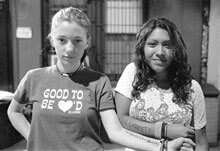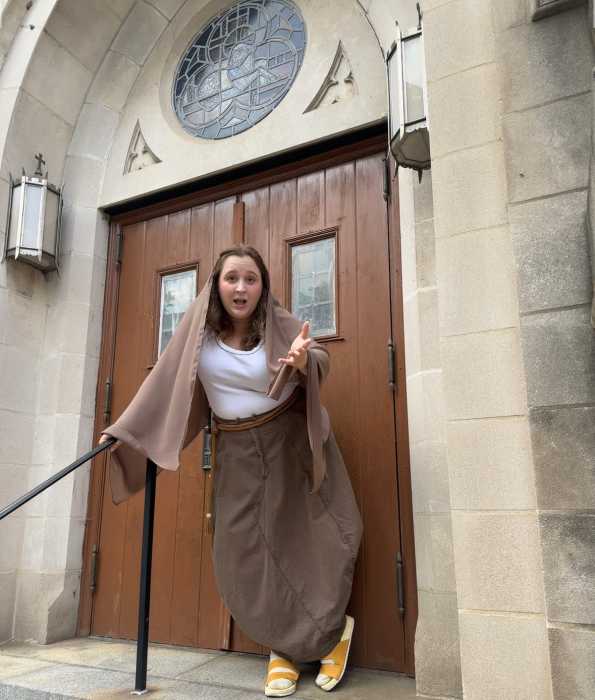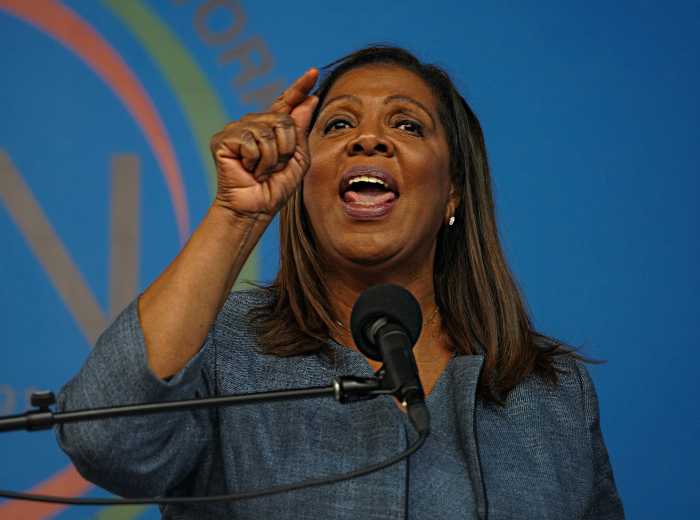Republican convention protesters speak out about abusive, prolonged detention they endured
Mayor Michael Bloomberg, in the days following the end of the Republican National Convention, crowed about the Police Department’s success in heading off major disruptions by protesters targeting the GOP, but it has become increasingly clear that keeping the peace for Pres. George W. Bush came at a price.
The other side of the story is the growing number of people who have come forward telling of unjust arrests and illegally long incarcerations at the now-infamous Pier 57—dubbed “Guantanamo on the Hudson”—and at Central Booking, otherwise known as the Tombs.
These include people who do not identify as anarchists and who were not planning on getting arrested in protest actions, but nevertheless got caught in the police dragnet and were made to pay for it.
In some cases, these individuals were held for as long as 50 hours, well beyond the legal limit. They tell of plastic Flexcuffs that cut their circulation, leaving their hands numb; insensitive if not outright cruel officers who refused to loosen the cuffs or provide prompt medical attention to those in need; filthy, oil-covered floors at Pier 57 on which they had to sleep; and stale and moldy food—“green bologna” sandwiches and moldy soy for vegetarians—they were served.
This newspaper spoke to five people who were among the more than 1,800 arrested in connection with the convention. All five contend that at the time of their arrest they were doing nothing illegal and certainly nothing justifying being held so long. While their experiences and individual reactions differed somewhat, they all agree on one thing: the experience was hell.
Three 18-year-old friends from Queens, Melissa Loayza, Caitlin Lemmo and Danielle Walsh, ended up being detained for roughly 50 hours, half of that time at Pier 57 and half at Central Booking. The three had come to Union Square on Tuesday afternoon, the second day of the convention, to check out Japanese comic books at Forbidden Planet and CDs at the Virgin Records Megastore. Later, while sitting on a bench in the park, they heard an upbeat protest march gathering nearby and went to take a look.
They had been planning to attend Thursday’s protest, sponsored by ANSWER, an anti-war group, in the designated protest area on Eighth Avenue south of 30th Street, just below Madison Square Garden, where the delegates met. Seeing the crowd on Tuesday, however, they decided to join the protesters who were headed toward the Garden. As opposed to the ANSWER rally, however, the city had not issued a permit for this march. Tuesday was the day the ad hoc A 31 Action Coalition had called for direct action—civil disobedience—in the streets.
“We just saw this street party and we decided to join in,” said Loayza, who was not exactly dressed in proper protest attire, wearing pumps with 2 1/2 –inch heels, a skirt and a tank top. “We walked up to 16th Street and the police told us to turn around and walk the other way, and then we saw the street was blocked at the other end: They were trying to corral us.”
“All of a sudden you hear ‘Get on the sidewalk,’ and we were already on the sidewalk,” recalled Walsh. “Now we’re squished and the police are like, ‘You’re all under arrest.’ There were three rows of cops—and then we were netted with orange netting.”
The march was being led by a band, and Loayza said the police made a point of arresting people playing instruments. There was intense scuffling between police and some of the protesters.
“A girl gave a cop a look and he took her by the hair and threw her into the street,” Loayza said. “Later on, I saw and heard pepper spray. They either sprayed it at someone or just to scare people. Other people told me that they saw the can—it was pretty long.”
The protesters were Flexcuffed and an arresting officer was assigned for every five protesters. Their belongings were taken from them and put in plastic bags, after which the marchers were taken to Pier 57 on the Chelsea waterfront.
At the pier, they were put into large, makeshift pens topped by barbed wire. Each pen had portable toilets outside, and there were hourly bathroom breaks. There were a few benches in each cell, but not enough.
“That was horrible,” Loayza said. “You could see all the dirt [on the floor] and there were two Port-a-Potties for 80 women. And our bodies got really dirty. I didn’t want to sleep on the floor because it was so dirty.”
Lemmo luckily was wearing pants. She tried to sleep as much as possible, though she put a bandana by her face in case she rolled over onto the oily floor.
Among people arrested on 16th Street with them were some who weren’t involved in the march at all, including a German tourist and a young woman who was going to the movies, Loayza said.
Loayza said the worst experience was being taken in a Corrections bus down to Central Booking, when officers put the Flexcuffs back on, this time painfully tight. She was put in a seat on the bus that was glassed in, causing her to faint from lack of fresh air. Only when other arrestees on the bus yelled did officers respond and let Loayza out.
Added Lemmo, “My cuffs were pretty tight after the arrest, but they got tighter at Corrections. My wrists were purple.”
“My fingertips turned blue. I told them it was cutting off my circulation and the officers just laughed,” said Walsh.
Once at Central Booking, the young women had their mug shots taken and were electronically fingerprinted and moved from cell to cell, up to six or seven times. At this point, they were mixed in with the general prison population. Loayza said there was a woman arrested for fighting and another for petty larceny in her cell. She and her cellmates asked for blankets or something to sleep on, and got nothing, though she heard people in other cells were given thin floor mats.
Officers were slow to respond to any sort of medical condition, the women said.
“There was this girl who had one-day contacts on, but it was two days,” Loayza said. “Her eyes got swollen shut. We asked for help, and they said they’d call EMS—but they never came.”
Lemmo briefly shared a cell with a women from Philadelphia who said she had been mistakenly arrested with the War Resisters League, who attempted to stage an non-permitted march from the World Trade Center to the Garden on Tuesday. She was arrested shortly after getting off the subway to visit the World Trade Center site.
“Only one cell had cockroaches,” Lemmo recalled of her experience at the Tombs. “I just kept thinking, ‘I’m going to get through this.’ ”
After acting State Supreme Court Justice John Cataldo ruled that the city would be held in contempt for holding the protesters more than 24 hours without arraigning them, and subject to a $1,000 fine for each protester held beyond that limit, the city finally released the three women on Thursday. They got out between 6 p.m. and 8 p.m. It was late and they were tired and dirty, so rather than go to the protest march just below Madison Square Garden, they went home to recover. That was the mayor’s goal, they believe—keeping them under arrest long enough that they would not be able to join the protests.
Walsh is particularly bitter about her experience and is looking forward to possibly being a part of a class action lawsuit or filing an individual lawsuit against the city.
“America, land of the free—this is not land of the free, because I can’t walk down the block,” she said. “This is worse than the death of my father. This is the most horrible experience I’ve had in my life.”
Concerns have also been raised about asbestos exposure on the pier.
“I can’t believe I had to send my clothes for asbestos decontamination,” said Walsh.
Like the march on 16th Street, the War Resisters League (WRL) marchers downtown were also swept up in an orange net in a mass arrest, in this case at Fulton Street near the Trade Center site. However, in contrast to the relatively youthful crowd at Union Square, the War Resisters League march included many middle-aged participants as well as senior citizens.
Simon Harak of WRL said that the group made no attempt to get a permit for the march.
“We felt that we had the right to free assembly and free speech, that it’s given to us in the Constitution,” he said. “Why should we have to apply for it?”
They had planned to march two by two, but the march got crowded at the front due to the presence of 40 to 50 members of the press as well as legal observers, he said.
“Then they blocked off the front and then a [police officer] in a white shirt comes in screaming ‘Seal off the block! Seal off the block!’” he related. The police then began efforts to net the protesters and arrest them.
“I never heard why I was under arrest,” Harak said, who said he sat at the scene for two hours in Flexcuffs before police took the arrestees to Pier 57.
“One of the guys I was arrested with was 77-years-old,” Harak noted.
Jim Flynn, a special education teacher at Humanities High School in Chelsea and a journalist photographing the event for a project on the convention, and was arrested, said the WRL crowd acted in a civil fashion.
“We had grandmothers there. We had kids. We had a priest,” he said.
The marchers had planned to block traffic by holding a die-in as close to the convention as possible, but insisted they planned to be non-violent. Harak said that at the time of their arrests, long before the planned die-in, the protesters were doing nothing illegal.”
“They cannot arrest us on intent—that’s a police state,” Harak said. “We had announced [the die-in], but they didn’t know which one of us was going to violate the law.”
Flynn said that before they were arrested, the marchers had chanted “Let us disperse! Let us disperse!” At the pier, he said, there was another chant, this time a version of the familiar Queen musical refrain: “We will, we will—sue you!”
Civil rights attorney Norman Siegel said the arrests of the marchers represent a disturbing, new trend, likening it to the movie “Minority Report.”
“In ‘Minority Report’ the government has the capacity to arrest you for thinking of breaking the law,” Siegel said. “Up to this point in America you get arrested for the conduct, not the thinking or the advocacy of the act.”
Siegel said city lawyers in defending the arrests will likely argue either one of two things—that the protesters were marching without a permit or, more likely, that they were blocking pedestrian traffic.
However, he said, “It basically is a preemptive arrest.” In addition, he said, “The problem with the net is it sweeps in innocent bystanders.”
In New York State, one must be arraigned on charges within 24 hours. According to Siegel, being given a desk appearance ticket, which is what 81 percent of the 1,821 arrests likely received—for disorderly conduct—usually takes from two to six hours.
“[The city] was telling everyone they were prepared for 1,000 [arrests] a day,” Siegel said. “But even on days when there were very little arrests, they still held them a long time. The bike people on Friday night [before the convention], on Ninth Street at Second Avenue, some of them were in there for 24 hours—and there were only 200 arrests that night. It leads to the strong possibility that this was by design, that they did it on purpose to hold them until Bush left, or so they were too tired to go protest.”
Siegel noted that there was only one day when the city reached the 1,000 arrest mark in connection with the protests—Tuesday, August 31, when 1,200 people were arrested in four hours.
Siegel, who is one of the lead attorneys representing the detained protesters, pressed for Justice Cataldo to hold a hearing to determine how many protesters were held past the 6 p.m. deadline on the convention’s final day, and the city has now turned that list over to the court.
Speaking to reporters after a hearing in the case last week, Michael Cardozo, the city’s corporation counsel, said that the city was overwhelmed by the number of arrests—he specifically cited the 1,200 arrests in four hours on August 31. Cardozo placed a portion of the blame on the arrestees, saying, “The Internet had told protesters to load up their backpacks with as much stuff as possible.” He also said that the volume of fingerprints being sent to Albany was huge, so the response time back was slower than usual.
“We were faced with extraordinary circumstances,” Cardozo said.
Asked for the reason for the large number of arrests in connection with Union Square and War Resisters marches on August 31, Officer Christopher Filipazzo, a police spokersperson, issued the following statement: “The public was informed well before the RNC started that anyone breaking the law would be arrested. Protesters were informed before each demo that anyone who broke the law would be arrested… A person is guilty of disorderly conduct when, with the intent to cause public inconvenience, annoyance or alarm, or recklessly creating a risk thereof, he disturbs vehicular or pedestrian traffic or he congregates with other persons in a public place and refuses to comply with a lawful order by police to disperse.”
Attorneys for the protesters suggest that a class-action lawsuit is possible, based on false arrests and violations of constitutional rights.
“Keeping people under arrest too long is unconstitutional,” Siegel said. “There were people that were held almost due days. That is unacceptable.”
Asked about the possibility of lawsuits, Cardozo responded, “Who is it that is actually suing us? We don’t actually know the answer to that question.”
The next court date in the case is September 27. City Councilmember Bill Perkins (D-Harlem) held hearings on the police actions on arrests and detentions on Wednesday, but no administration officials appeared.
Zack Winestine, a Greenwich Village community activist, had the good fortune of participating in several protest actions that resulted in arrest, yet somehow evaded the nets.
Winestine was among the group of about 5,000 at the final protest march of the convention on Thursday night as Bush was giving his speech. The march—which he said had the exhilarating feeling of a triumph—did not have a permit, but police nonetheless let it proceed from Union Square, where there had been a candlelight vigil, up the street on Eighth Avenue to the protest area just below Madison Square Garden. On the way through Chelsea, residents hung out of windows and cheered. Police had made an agreement with the protesters, but not everyone was convinced it would hold.
“I was a little nervous crossing 15th Street, because I thought that’s where the cops were going to shut it down,” said Winestine. “But it was a nice finale. Good spirit, good energy.”
































